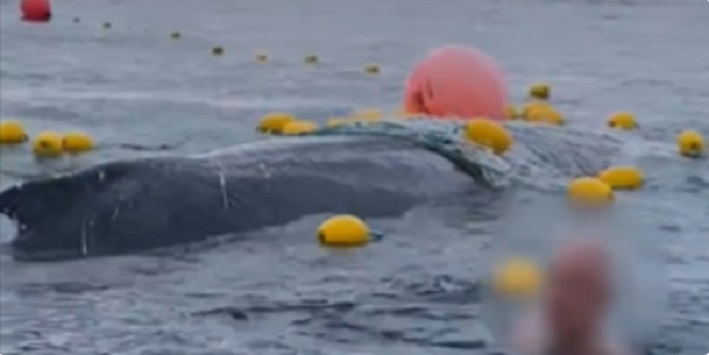Australians Rescue Humpback Whale from Net, Face Hefty Fine
On a sunny Monday in the tropical state of Queensland, Australia, a group of young Australians made a daring and compassionate decision that would put them at odds with the law. They spotted a humpback whale entangled in a shark net off the coast of Marcoola Beach and, unwilling to wait for emergency services, took matters into their own hands.
The whale was in distress, barely able to move, its body completely ensnared in two layers of netting. Without hesitation, the group of four jumped into the water with their paddleboards and began cutting through the net with a knife, determined to free the massive marine mammal.
“It was on the surface, but it wasn’t moving,” recalled one of the rescuers, Brenton Owens. Their top priority was to remove the parts of the net that had covered the whale’s eye, hoping to calm the animal down and allow it to regain its strength.
After a tense and arduous effort, the group managed to free the humpback whale, which immediately swam away, seemingly relieved and rejuvenated. The ministry confirmed that a report of a whale in distress had been received, but by the time the experts arrived, the whale had already been liberated by the courageous individuals.
However, the group’s heroic actions have now landed them in legal trouble. Under Queensland law, people who do not maintain a distance of at least 100 meters from a whale in the sea face a fine of up to 19,300 Australian dollars, unless they have a “reasonable reason” for their proximity.
Additionally, the law requires a distance of 20 meters from shark nets, a regulation the rescuers also appear to have violated.
A spokesman for the Department of Agriculture and Fisheries (DAF) stated that the ministry was considering launching an investigation into possible violations of these laws following the incident. “For their own safety, we remind the public not to approach or attempt to free whales caught in nets,” the spokesperson stressed.
The warning echoes the sentiments of Naomi Gardiner, a lecturer in marine biology at James Cook University, who cautioned about the unpredictable and dangerous behavior of stressed whales. “Humpback whales are huge animals, exceptionally heavy, and when in distress they behave quite unpredictably,” Gardiner said. “The pectoral fin alone can be five metres long and weigh up to a tonne. Stressed whales can knock people unconscious or even kill them with a single movement of their body.”
Despite the potential legal consequences, the group’s actions have been praised by many, who see their intervention as an act of heroism and compassion. The rescue highlights the complex relationship between humans and the natural world, where sometimes the desire to help can come into conflict with established laws and regulations.
The incident also sheds light on the ongoing challenges faced by marine life, particularly endangered species like humpback whales, which must contend with human-made threats such as entanglement in fishing gear and shark nets.
Across Australia, the population of humpback whales has been slowly recovering after decades of whaling took a toll on their numbers. However, the threat of entanglement in nets and other marine debris remains a significant concern for conservationists and wildlife authorities.
In the wake of this incident, the public and authorities will likely engage in a broader discussion about the balance between protecting human safety, upholding the law, and preserving the wellbeing of marine life. The outcome of the investigation into the rescuers’ actions will be closely watched, as it could set a precedent for future cases where the instinct to help an animal in distress may clash with the letter of the law.
Ultimately, the story of the Marcoola Beach whale rescue serves as a poignant reminder of the delicate and often complicated relationship between humans and the natural world, and the need for thoughtful and nuanced approaches to conservation and wildlife management.
